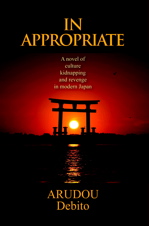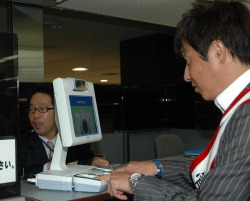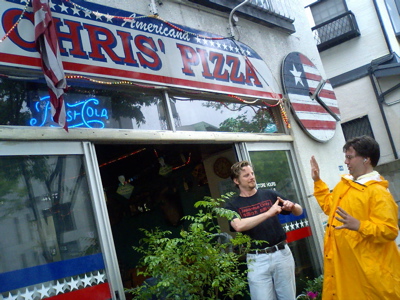mytest
Hello Blog. Let’s give you a report on a fascinating week, this time blogged instead of the regular html format:
KYUSHU CYCLETREK 2007
MIYAZAKI TO FUKUOKA, VIA THE COASTAL ROUTE
By Arudou Debito, Sapporo, Japan
May 13, 2007
This is not the first time I’ve done something like this. I’ve undertaken a number of cycletreks (see one of my favorite essays at https://www.debito.org/residentspage.html#cycletreks), the last one last summer where friend Chris and I cycled from Sapporo to Abashiri via Wakkanai and Monbetsu (total for me, 940 kms over nearly two weeks). But cycling can be addictive, so long as you can take a bicycle seat numbing your tuckus all day, since it ultimately becomes meditation with a view. And by the end of around the third day, when your body has become accustomed to exhausted early nights crashing in a tent, followed by amazingly-full raring-to-go recovery by sunrise, you get into a rhythm and a self-actualizing sense of accomplishment: You have fuel, functional legs, full tyres, and a flat surface to cycle upon. You feel as if can go anywhere, do anything. All that stands between you and your destination is time–since distance (when you go at least 100 kms a day) becomes surmountable…
Anyway, with that in mind, here’s where my legs took me this Golden Week…
THE ENTIRE ROUTE:
Here’s a scan from my brand-new TOURING MAPPLE –a new map designed for those who wish to see Japan on two wheels (with tips on where to eat, stay and see for motorbikers):
–a new map designed for those who wish to see Japan on two wheels (with tips on where to eat, stay and see for motorbikers):
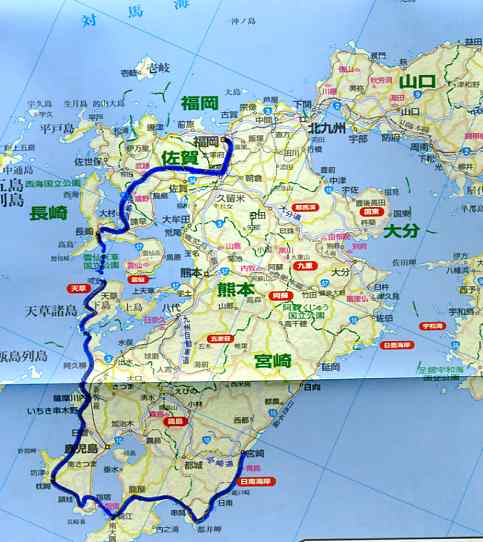
The island is Kyushu, Japan’s southernmost big island containing Fukuoka as its metropolis. The route I took is traced in blue. Total distance covered: 768 kms over the course of ten days. Average speed for the duration of the trip, 13.1 kph–which sounds pretty doddering (my trip last summer averaged 16.9 kph) until you take into account the difference in terrain between Hokkaido and Kyushu…
=======================================
DAY ONE: APRIL 27, 2007: TOKYO TO HANEDA, THEN AROUND MIYAZAKI
TOTAL DISTANCE: 48 KMS
Friend Chris (who had the original idea of cycling around Kyushu in the first place–I was originally considering starting in Kurashiki and heading down counterclockwise around Shikoku) put me up in his apartment, and we cycled the surprisingly long distance to Haneda Airport (it’s at least 20 kms from downtown Tokyo) to get our bikes loaded on a regular domestic flight (they won’t take bikes without the front wheel taken off and all the loose parts stuffed into a bike bag, of course). But once finished (JAL, although it won’t take any responsibility for any damage incurred en route, was very good about packing), it was very comfortable to fly in cycling clothes with no luggage for a change.
Once in Miyazaki, I introduced Chris to my favorite chicken nanban restaurant (he’d never had the stuff, but it’s a staple in Miyazaki Prefecture). Then we enjoyed the hospitality of friends in Kyushu (Steve and Masako van Dresser), who proteined us up for the trip, and let us use their living room floor (we had bedrolls and sleeping bags, so no worries).
======================================
DAY TWO: APRIL 23: MIYAZAKI TO POINTS SOUTH
AOSHIMA, NICHINAN, KUSHIMA VIA TOI MISAKI, SHIBUSHI
TOTAL DISTANCE: 168 KMS
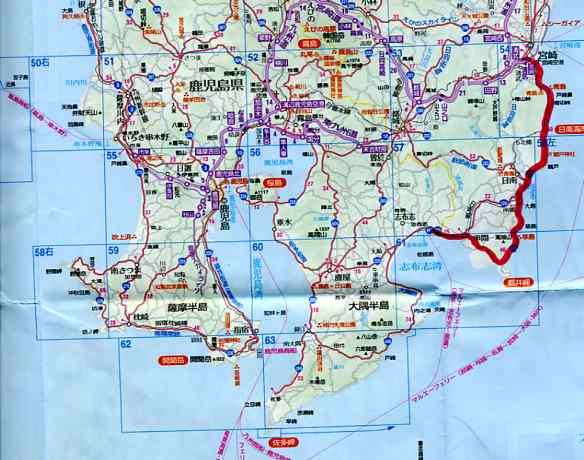
I’ve been on three separate other cycletreks totaling around a month, and I must say: This was the most difficult cycling day I’ve ever had. And it just had to come on the first day, of course. Although the map indicates that the road hugs the coast (indeed it does), Miyazaki’s roads in this region start about 50 or so meters up on each cape, zooming inland and downhill to a town with a beach and a traffic light (which kills your precious momentum). Then another uphill greets your journey to the next cape rising about 50 or so meters again in elevation. In Hokkaido, at least (the site of all my other cycletreks), coastal roads stay close to sea level most of the time.
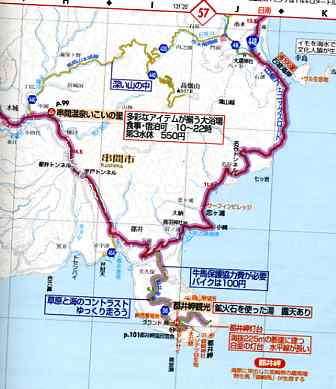
Closeup of Toi Misaki. Doesn’t this look flat to you? The coast, I mean. Heading south then west.
This daylong slingshotting up and down took an incredible amount of energy out of me (Chris less so, it seemed–as he’s more than 15 years younger than me, and with a brand new, light, state-of-the-art cycle jeering at my boneshaker of a mountain bike). Not to mention the weather was clear and lovely, but with a small enough headwind to hold me in place and toast the spots on my arms and feet I had missed coating with sunblock…
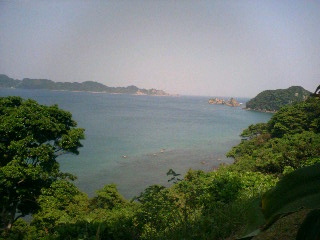
Some of the many beautiful bay views in southern Miyazaki. Pity we’re looking down upon them from such a high altitude…
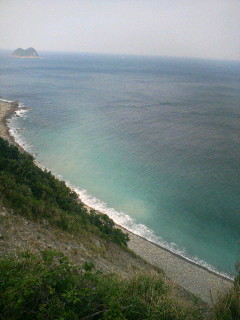
Turns out Day Two was an overture of road conditions that would last the entire trip: Zoom down, climb up, repeat, repeat… Then start having thoughts about the cursed inverse proportion of Potential and Kinetic Energy, and the tyranny of the Conservation of Momentum. I hate hills–I mean absolutely *loathe* them; I am not an athlete and always look for the easiest way to get from here to there (hence I credit my cycling mileage to mere stubbornness). Alas, hills are much of what the terrain down here is. Kyushu is in desperate need of an Ice Age…
Lesson we soon learned for those who follow in our wake: If you want to get anywhere in Kyushu in decent time, without a motor, and without significant anaerobic acid buildup in your muscles, stick to the main roads. They generally have some semblance of shoulder or bike path, and remain under ten degrees in slope. Otherwise, all bets are off (there was one detour in Nichinan that involved a hastily-built road with bits–I swear–with about 25- to 30-degree slopes. Don’t think that the small-scale side roads are going to give you scenery worth the effort. Get a motorcycle if you really want to explore.
We cycled past sunset, just made it across the border from Miyazaki Prefecture into Kagoshima Prefecture, and spent the evening in a resort onsen hotel, with baths and nap-inducing reclining chairs. Until we were booted out into the night…
========================================
DAY THREE: APRIL 29: AROUND THE RINGS OF KERRY (SATSUMA STYLE) WHERE DISASTER STRUCK
SHIBUSHI, KANOYA, SATA, IBUSUKI
TOTAL DISTANCE: 255 KMS
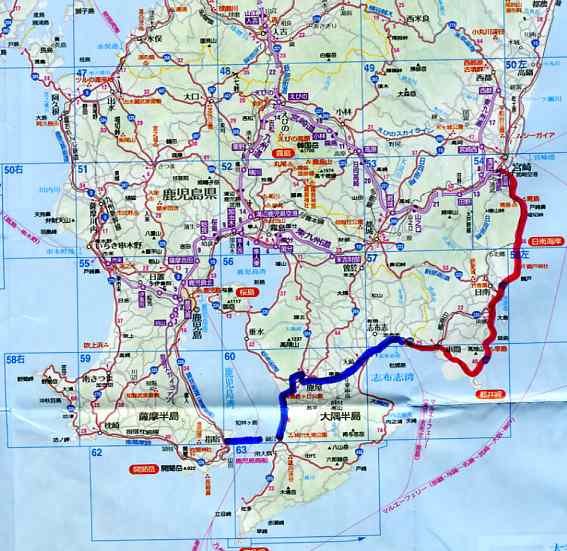
If you really get cartoony about it, Kyushu is shaped vaguely like a upturned cupped hand reaching south to scoop up the islands leading to Okinawa. Our plans were to cross the pinky and head north to Kagoshima City, with its perpetually erupting volcano in the crook of the pinky and ring fingers called Sakurajima. That, however, was not to be.
This being Golden Week, the time when Japan has the most potentially consecutive holidays all year, all the hotels were booked in the onsen areas of port town Shibushi. No worries–tent and sleeping bag were bungee-corded to the back of my cycle, as per plan. What was not according to plan was Chris’s announcement as we were pulling up to Kanoya, Kagoshima Prefecture’s second city:
“Just got word through my keitai. Family emergency. I’ve got to return to Tokyo immediately.”
Oh hell. So be it. I saw Chris off at the Kanoya bus station (he made plane reservations from Kagoshima to Tokyo in minutes on his cellphone), and I went on alone.
That was better. Nobody to worry about falling behind or keeping up with, or taking responsibility for best-laid plans gone agly. I wound up taking the wrong road, found my way back to the coast, and cycled along the lovely seaside towards Sata (mainland Japan’s southernmost tip–but too hilly for my liking), embarked on a ferry across the bay to Ibusuki (famous for its hot beach sands–get buried up to your neck and experience one of the most relaxing situations ever), and found myself in a campsite overlooking an island connected to the mainland only at low tide.
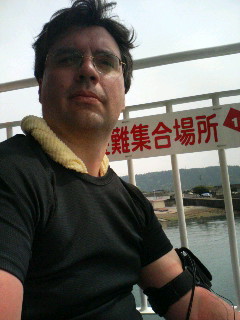
Exhausted, but made it aboard the ferry to Ibusuki with less than ten minutes to spare…
I was too tired to do much but just pitch my tent, unzip my sleeping bag, and fall asleep shortly after sunset. Again, it takes a couple of days for the body to get into the rhythm…
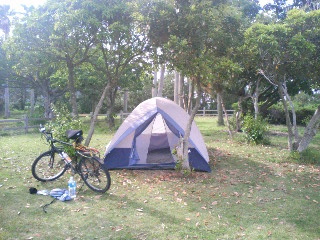
====================================
DAY FOUR: APRIL 30: GETTING MY MOJO ON
IBUSUKI TO LAKE IKEDA/KAIMON DAKE, MAKURAZAKI, UP THE COAST TO KASEDA
TOTAL DISTANCE: 345 KMS
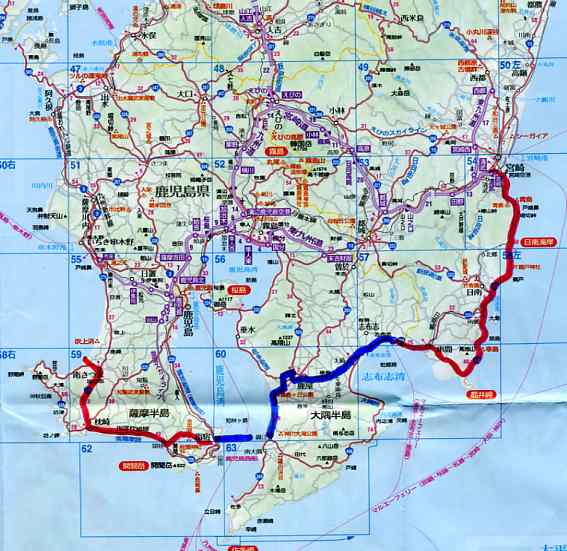
Again, cycling alone was advantageous because I lost two hours taking the wrong road up a caldera to see Lake Ikeda. To quote Led Zeppelin, nobody’s fault but mine. It wasn’t cycling after a while–it was just pushing the bike up the switchbacks, but that in itself was a nice break from pedaling (i.e. it uses different muscles) and the road was shaded. Interesting also was that occasionally people would actually stop their cars, get out, and talk to me about where I was from and where I was going (the baggage of dealing with a White face speaking Japanese took less time than average to get over, it seemed). And once over the rim of the crater, I was rewarded with a lake view backgrounded by Kaimon-Dake, the Mt. Fuji of Kagoshima Prefecture with its near-perfect cone.
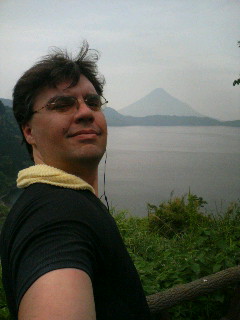
The view of Kaimon-Dake from Ikeda-ko. That’s not the ocean. That’s a lake. Lake elevation 60 meters, I’m at about 100 meters along the caldera rim.
However, I found I wasn’t making good time–it was nearly lunchtime and I hadn’t covered much more than 20 kms, so off I went along the reasonably flat coast to the southernmost city on the ring finger peninsula–Makurazaki.
Famous for its bonito (katsuo), Makurazaki is an industrial seaport town with its coast barred by a wall of cement tetrapots–as if it once got hit by a tidal wave and wasn’t going to get fooled again. Entering the city was no more pleasant–it reeked of smoke and looked run-down and Dickensian. Was glad to head inland on the main road as far north as I could reach that day: Kaseda, or after consolidation with nearby towns, Minami Satsuma City.
I found myself in a marvelous campsite (on a site that apparently had military connections during the war; war memorials to the Tokkoutai (“Kamikaze” pilots) are scattered throughout Satsuma) on coastal Kaseda, being put up in a tent within a tent that could stand a typhoon (we did in fact get zapped by a storm that night, which during my cycle coma I hardly noticed). It was the site of the national sandcastle festival, opening that night, so I got a free fireworks display thrown in. One of the nicest evenings of the trek.
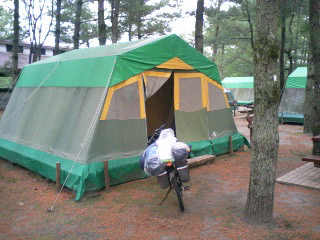
A tent within a tent at Fukiage Hama. Built like a brick shithouse. Could even stow the bike out of the weather within the first layer of canvas…
=======================================
DAY FIVE: MAY 1: GETTING INTO THE RHYTHM
KASEDA, FUKIAGE BEACH, SENDAI, AKUNE
TOTAL DISTANCE: 434 KMS
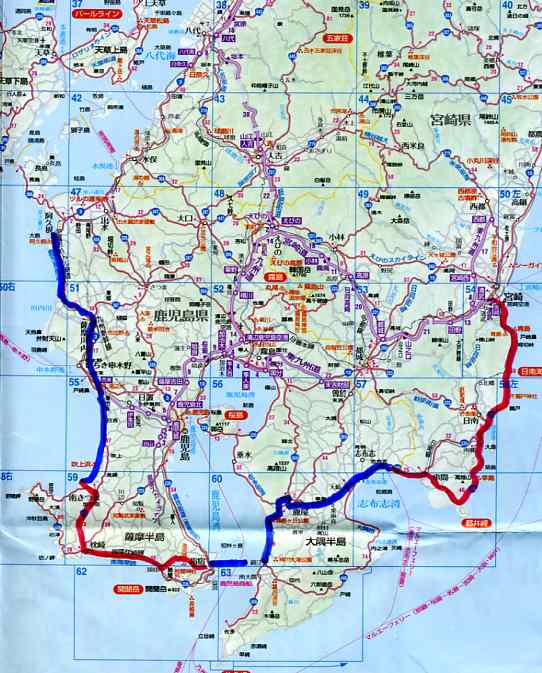
The storm had blown itself out, and I was able to take a cycle path following Fukiage Hama, a 40-km beach famous as a nest for sea turtles.
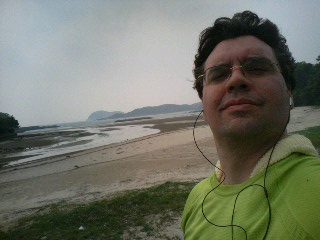
A leisurely cycle along rice paddies, windbreak trees, and odd valleys filled with freshwater crabs clacking their way into nooks and crannies (redolent of that scene battling bugs in Peter Jackson’s KING KONG) made me glad I was not miniature. Sunburn had gone a painless burgundy (thanks to evening baths in cold water–a mizu buro was always available in every bathhouse I visited nightly), and once the cyclepath ended 30 kms later, I found myself playing chicken every now and again with trucks on shoulderless roads, wondering if I should take a side road–and realizing I had better not.
In Akune, I found a hotel in my Touring Mapple which had a room, and to my surprise the price listed in the book (a little over 6000 yen including two meals) not only was inapplicable (due to Golden Week), but also the 7500 yen holiday price they quoted me instead wouldn’t even include meals. I called the manager, showed him his Mapple listing, and said I would accept the holiday price (GW premiums were understandable) but wanted meals included. He obliged, and I made up the difference with the cheapest meal on the menu with a side order and a beer. The manager said he would be in touch with the Mapple publishers with a correction…
=======================================
DAY SIX: MAY 2: MARATHON MAN
AKUNE, NAGASHIMA, AMAKUSA, AND ZERO NORTH
TOTAL DISTANCE: 535 KMS
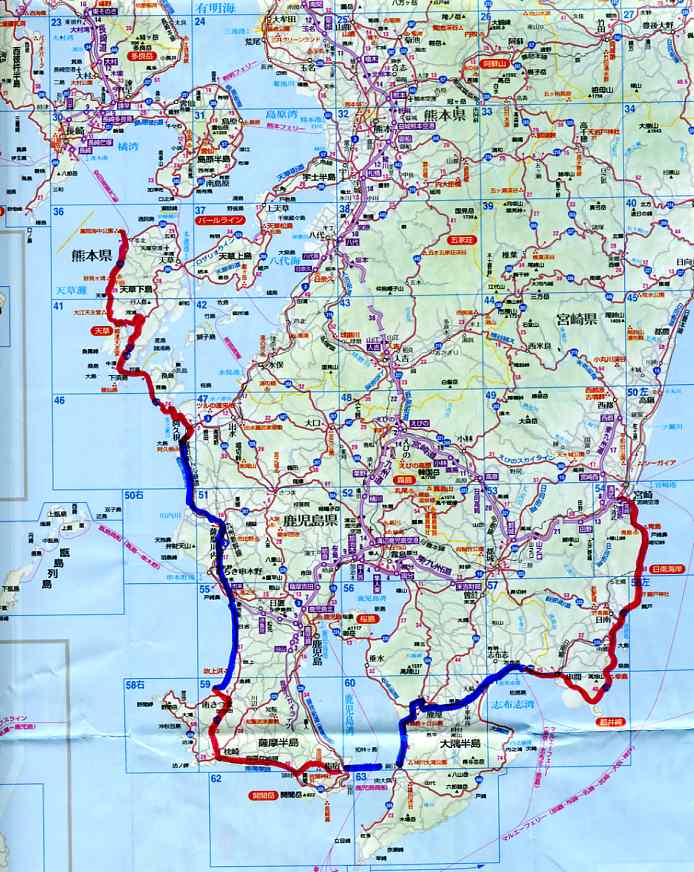
This would be the most ambitious day on the road, as I would be covering a good distance with some difficult terrain, crossing two islands. Akune to Nagashima Island was fairly pat, with a swift current and a whirlpool under the bridge across, and some lovely terraced paddies covering too much topography. But otherwise the only thing of note was a shed storing a right-wing sound truck (so this is where they keep them…). Ironically parked in front was a jet-black Mercedes, with the circular logo clumsily removed (it’s not Japanese, after all). I reached the ferry between Nagashima and Amakusa islands before lunchtime, and celebrated the half-hour ferry break with a well-deserved nap.
This finally got me out of Kagoshima Prefecture, a place I found (particularly the ring finger and Nagashima) to be sullen and in parts impoverished. Kumamoto Prefecture, starting with Amakusa, seemed much richer, both in culture (there is a long, deep, Christian history with some towns, such as Sakitsu, built around a church!) and in income (receiving port Ushifuka was rich and full of public works). People seemed friendlier and more receptive to tourists (many of the signs were in Korean), and my stop by a roadside stand serving champon (again, recommended by the Mapple) got me a decent bowl of noodles served by a hospitable waiter overlooking the rising tides of the bay.
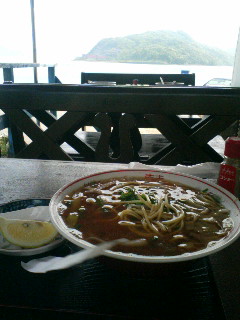
Champon with a view
But as I aimed my bicycle at Reihoku (a city at the top of the island, which I translated as Zero North until I realized the kanji for “nought” was different), I realized that what the champon restaurateur warned me was true–the roads would get steeper and narrower, down to nearly one lane even on a national road.
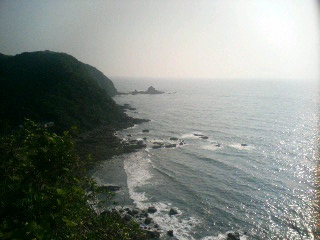
A lovely view. Much appreciated if you didn’t have to cycle up and down several of these per day…
Over the course of this trip I felt every kilometer, doddering slowly enough to see monkeys, ferrets, gigantic poisonous centipedes, and all manner of wildlife. But once past the mountain bottlenecks, I had an 11-km home stretch along the coastal plain, racing the sun to the horizon in hopes of reaching Zero North before the winds picked up, and the temperatures dropped again for the night.
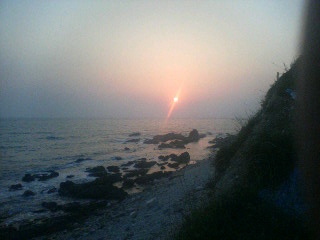
The sunset over Reihoku, arriving just in time…
I made it, only to find the Mapple-recommended seaside campsite was primitive, and the administrator (a nearby ryokan) would not sell me a meal or let me into their baths (“Guests Only”, they said). The closest bath was more than 4 kms away, it was already dark and windy, so I resigned myself to a sweaty night in the sleeping bag–my first ever in Japan.
In a foul mood, I biked down to the harbor looking for a meal and found a friendly hole-in-the-wall restaurant, whose patrons soon made conversation as I was their only customer. They were most interested to hear my complaints about the ryokan (“If they are the kanrinin, shouldn’t they be providing some at least some kind of bath? It’s not like they have to buy advance provisions for a meal.”), and promised to pass them up the ladder in this small town. Then they offered to drive me the 4 kms to the nearest bath and retrieve me an hour later. I gratefully accepted, and found myself with the local working-class folk fresh out of work at the town’s biggest industry–the enormous garbage incineration plant, whose twenty-storey smokestack dominates the city skyline. One of the gentlemen in the locker rooms, in charge of plant publicity and used to dealing with NJ visitors, befriended me, listened to my Ryokan Complaint, and also promised to pass it up the ladder. He then showered me with osenbei rice cookies (hey, this is Japan), rubber gloves (clueless why), and information about the town and the plant that he rushed out and got on his own recognizance while I was soaking. I was then dropped back off near my bike, where I cycled in the full moon back to my campsite feeling like I had had yet another one of my little Japan adventures…
========================================
DAY SEVEN: MAY 3: DAY OFF
REIHOKU TO NAGASAKI
TOTAL DISTANCE: 548 KMS
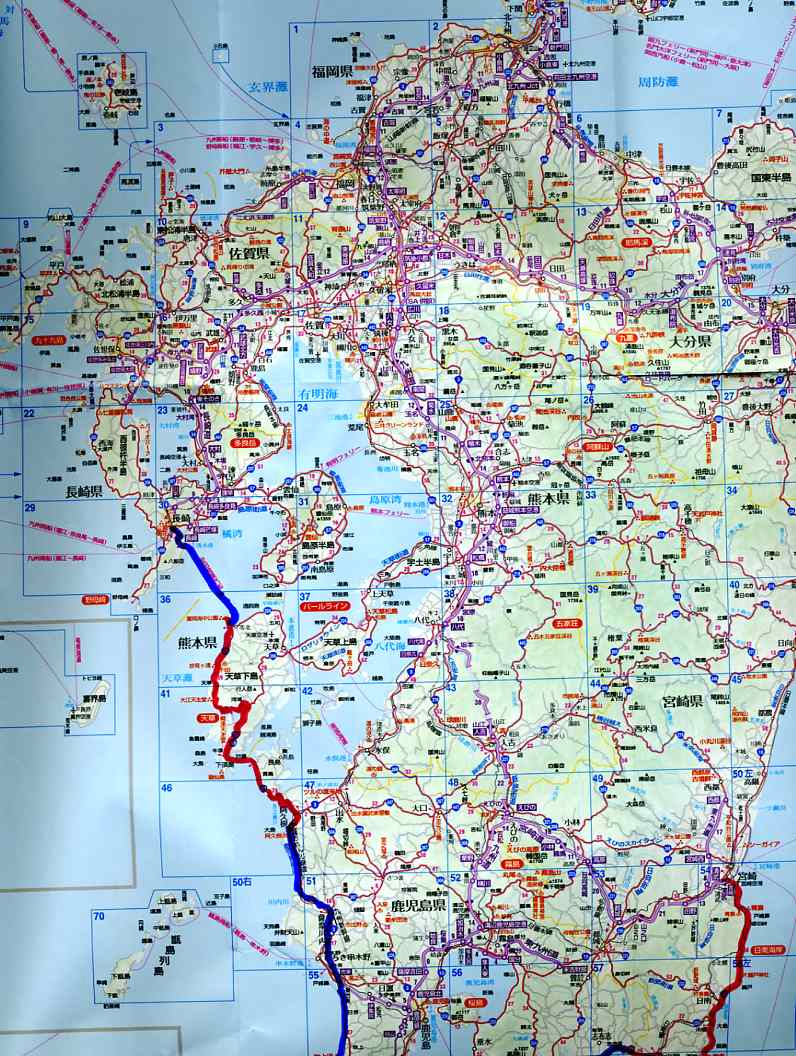
I caught the first ferry of the day (8:30 am) across the bay and left Central Kyushu for North. Maybe I’ve mentioned that I hated hills. Well–Nagasaki is nothing but, and getting there after an hour’s ferry ride meant surmounting an 8-km hill between Mogi and the city center. Done in surprisingly short time (when it’s the only hill of the day), I soon rolled into the pizza parlor of Chris Tierney, purchaser of my Japanese Only T-Shirt.
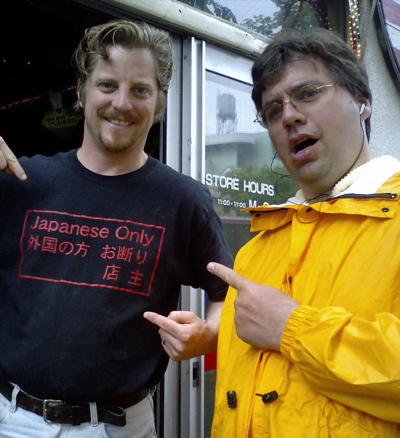
A professional pizza pie thrower (he’s appeared on Japanese TV, taking second place in a national competition, and his dough is the best part of his lovely little pizzas), I ate four of them at CHRIS’ PIZZA during my stay.

Here’s one of them, long since digested…
He also introduced me to several friends, and we not only had a nice walk around the beautiful city of Nagasaki, but also evening beers around his campfire site next to his house on the very top of the hill (which he amazingly walks two and fro every day to get to work).
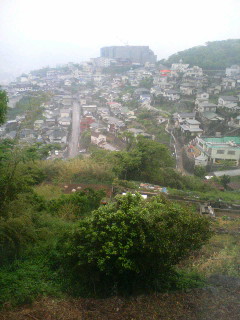
The view from Chris’s guestroom window in Nagasaki. Note hills.
This was the best night of the trek, and you can read about it a little more (with a photo) on one of the guest’s blogs (http://true-bitch.blogspot.com/2007/05/crusader-on-bicycle.html).
=====================================
DAY EIGHT: MAY 4: THE REACH NORTH
NAGASAKI, OHMURA, YOROKOBINO
TOTAL DISTANCE: 611 KMS
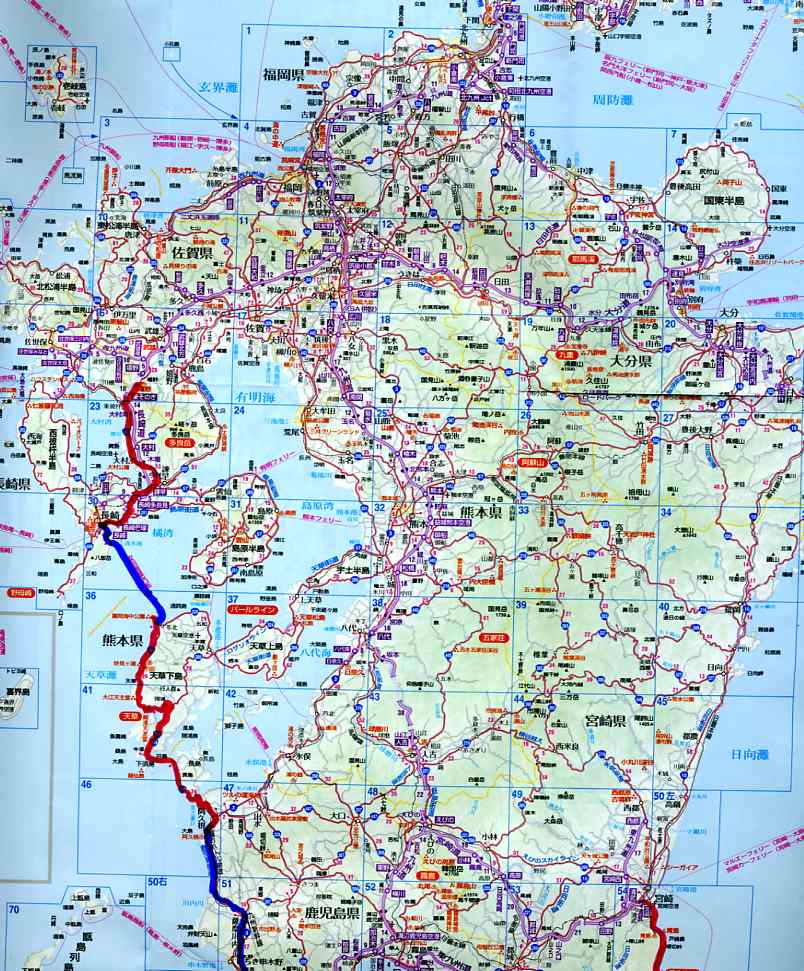
This day should have been total crap, since it was raining constantly (and would without much letup the rest of my trek). But I waited until lunchtime for some abatement, realized after a pizza it was now or never, and bid farewell to Chris (not before a photo–you can see me in my bright-yellow raingear above).
And it was essentially a total crap day. All I could do was dodge car splashes and keep listening to NPR on my iPod, and wonder just how much distance I could cover this day (since I had lost half of it due to a sleep-in in a real bed and a nice breakfast courtesy of Chris’s wife). Chris noted that he’d covered the distance between Nagasaki and the local airport in Ohmura in ten minutes on the expressway. But he’s totaled three cars, so he’s not much of a measure of sane speeds. Even still, I didn’t get through the damn place (the city itself is about 6 kms long) until nearly 4PM, and had the sinking feeling that I would be sleeping rough in the rain in my tent, something I always prefer to avoid.
But I had better luck this time. When I eventually turned inland and finished climbing a 5-km hill (not very steep, but punishingly long) at about 5 kph, I realized that the outskirts of onsen town Yorokobino had some Love Hotels. Problem is, they weren’t offering their overnights unless you stayed in the hotel from after 10 PM, and by now it was only 6 PM. Nevertheless, I pulled into the shabbiest one around (they would probably be more hungry for my business and less likely to be full), and talked the laughing matron of the establishment into taking me in. “Don’t tell our manager, but I’ll comp you two hours. Pay me one Rest Rate and then the Stay Rate and I’ll throw in your meal.” Deal. Total cost: 7600 yen. Given the size of the bed and the bath (big enough for two, natch), plus free TV (I could only stay awake for about an hour of it–devoted to the weather channel, not porno), and curry rice and cup noodle brought to my door. I felt snug and safe as I heard the rain pick up for the evening…
==================================
DAY NINE AND TEN: MAY 5-6: REACHING MY DESTINATION
YOROKOBINO, TAKEO, SAGA, AND FUKUOKA
TOTAL DISTANCE: 768 KMS
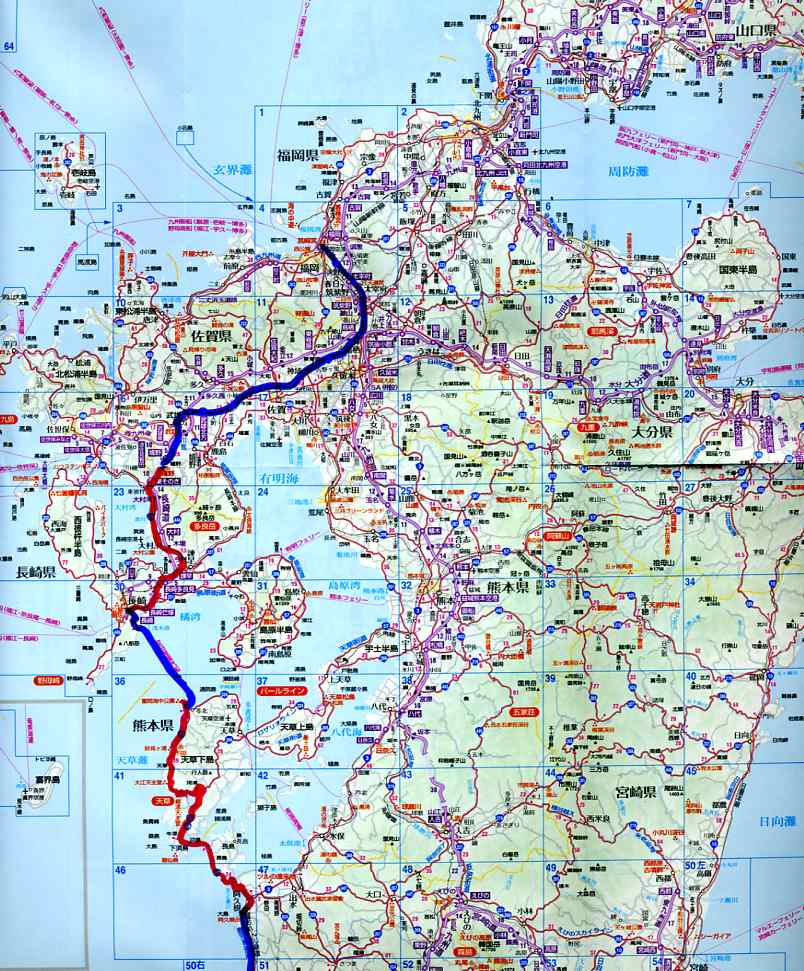
As I said, the rain just kept on coming down, so I slogged it through to the flatlands of Saga (there isn’t much but rurality in the whole prefecture), turned north towards Dazaifu, and realized that despite covering more kilometers than any other day (more than 120), thanks to the lack of topography I was in downtown Fukuoka long before sunset.
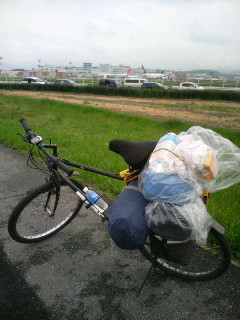
Arrival at Fukuoka Airport, trusty hoss as relieved as I…
My host, union activist Chris Flynn, took me into his brand new house, had me fed, and regaled me with stories of labor disputes won and lost. Since I had cut my trip a day short due to the weather, I spent the next and final day cycling around Fukuoka City proper, thinking I might see some of the man-made islands around the harbor. But when drizzle graduated up to downpour with chilly wind thrown in, I gave up and spent the day in a harborside onsen (ironically called Yunohana–the very name of the Otaru onsen which we sued successfully for racial discrimination) warming my bones. Another evening with Chris and family providing wine and SPIDERMAN on the TV later, I was cycling to the airport (probably the most convenient one in Japan–only two kms from the main train station, Hakata) the next morning to pack up my bike and head home, dressed only in short sleeves and shorts (I had thrown away my long-unwashed other clothes), to a Hokkaido about two months behind weatherwise.
==================================
CONCLUSIONS
I generally like to end my travelogues (see previous ones at https://www.debito.org/residentspage.html#OTHERESSAYS) with some insights into life, the universe, and everything. Doubt if I can this time, really. This report is one I have to toss off in one part because I have a lot of other essays, papers, and speeches baying to be finished.
But one lesson I think I have learned is that when it comes to the unpredictability of a journey like this (where there are so many variables, be it exhaustion, road conditions, fickle fancy of roadside attractions, and most of all the weather), it’s best (for me, anyway) to travel solo unless you really can relate to a partner. For alone, if something goes wrong, there are no fingers to point elsewhere, nobody to curse or blame but the fates, and no guilt for possible bad advice. And if people cycle at different rates, you either slow somebody down or feel like you’re being held back, which is a fun damper. I can’t imagine how others do these treks in groups.
I don’t feel alone in this. I saw other bikers on the trail (not many; about five), and three of them were not at all friendly. They kept themselves to themselves, and were not interested in sharing stories or discovering origins when they had to make a certain amount of distance before nightfall. Or maybe they just didn’t want me to break their meditation or stride. Suited me fine. The interesting thing was that the unfriendly ones looked older than me. Maybe that’s the future.

During one of my refuelling… er… eating breaks outside a konbini… Almost there. Don’t I look social?
Already looking forward to the next cycletrek (Hokkaido again, this summer),
Arudou Debito in Sapporo
May 13, 2007
KYUSHU CYCLETREK 2007 REPORT ENDS
